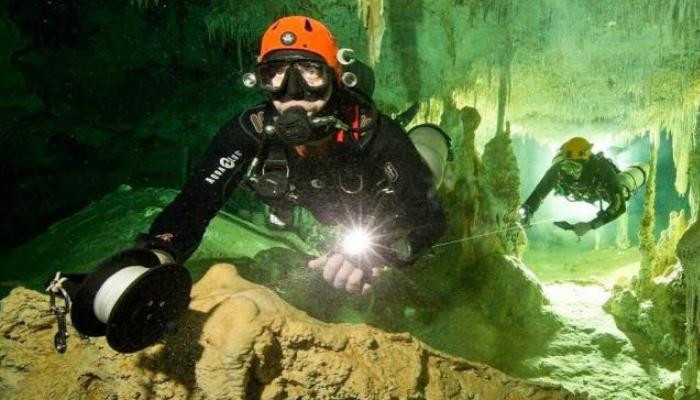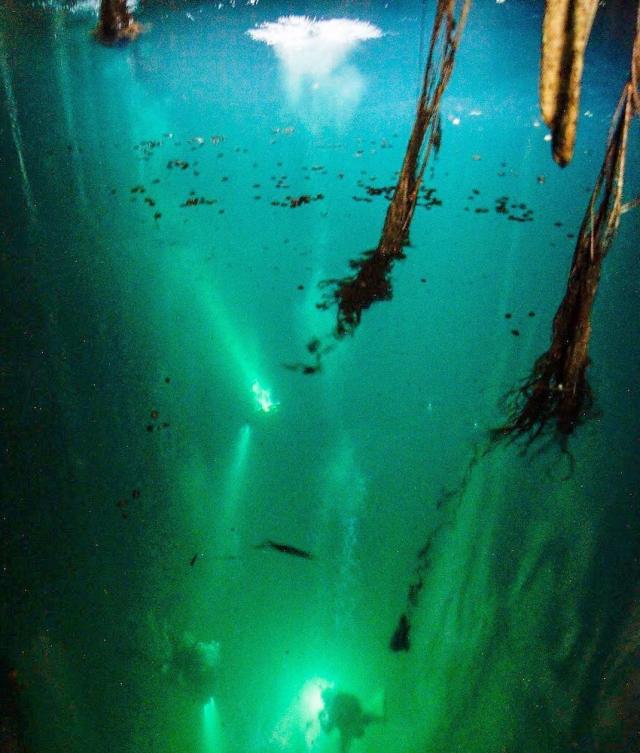World's Largest Underwater Cave Discovered
 The world's longest underwater cave has been discovered near the city of Tulum, on Mexico's Yucatán Peninsula. The new discovery connects two previously known flooded caves into one 215-mile-long stretch. The cave holds an important large fresh water reserve that supports great biodiversity. Hundreds of archaeological sites exist in the cave, including evidence of America's first settlers, Mayan culture, and extinct animals. Last Wednesday, after ten months of work, the Underwater Exploration Group of the Great Maya Aquifer Project (GAM) found a connection between two of the most extensive flooded cavern systems on Earth—Sac Actun and Dos Ojos, both in Mexico's Yucatán Peninsula—now forming the world's largest known flooded cave, with a length of 215 miles. "This immense cave represents the most important submerged archaeological site in the world, since it has more than a hundred archaeological contexts, among which is evidence of the first settlers of America, as well as the extinct fauna and, of course, of the Maya culture," says Guillermo de Anda, a National Geographic explorer and director of the GAM. This phase of the project began in March 2017 with the work of GAM director of exploration Robert Schmittner and a team of divers specialized in caves. Schmittner had been looking for this connection for 14 years and adding new mapped tunnels and galleries to this water labyrinth. So far, the 167-mile-long Ox Bel Ha System, located south of Tulum, Mexico, was the longest. The Sac Actun System, located northeast of Tulum, was ranked second, at about 163 miles. The third on the list was the Koal Baal System, with 57 miles; and the fourth, the Dos Ojos System, with 52 miles. Now, as a result of the exhaustive exploration, the latter is added to the Sac Actun System. According to the rules of caving, when two cave systems are connected, the largest cave absorbs the smallest, so the name of the latter disappears.The next goal will be to connect Sac Actun with the other three underwater cave systems, which are very close to each other and located in the municipality of Tulum. According to data from the Quintana Roo Speleological Survey, there are 358 submerged cave systems in the north of the state, which represents nearly 870 miles of flooded passages of fresh water. "THE MOTHER OF ALL CENOTES" "This is an effort of more than 20 years of traveling hundreds of kilometers of caves submerged in Quintana Roo mainly, of which I devoted 14 to explore this monstrous Sac Actun System. Now, everyone's job is to keep it [up]," says Schmittner. These "hundreds of kilometers" of underground passages have become true tunnels of time, guarding the remote and recent history of this Mexican region. TREASURE OF BIODIVERSITY This and other GAM efforts seek to better understand the subsoil, its biodiversity, and the relationship human beings have with these ancestral waters to achieve an adequate understanding of the natural resources that depend on this aquifer. The next phase of this ambitious project includes an analysis of the water quality of the Sac Actun System, as well as a study of its biodiversity and its conservation, in addition to giving continuity to the mapping and detailed record of submerged archaeological contexts. Tulum has become a mecca of cave diving. Underwater explorers from different latitudes have dedicated a great part of their lives to exploring this landscape. Among them, cave explorer Bil Phillips co-founded the Quintana Roo Speleological Survey, a database with detailed maps of these complex systems that is a tool to understand and protect the area. Phillips, who died in November 2017, explored this underwater world until his last days. For more than 40 years, he dedicated himself to understanding the depths of the site through the investigation of these ancestral waters. The GAM team dedicated their achievement to Philips, the underwater cartographer of the project. A CLOSER LOOK AT THE WRECKAGE OF THE TITANIC  |

Japan Unveils Human Washing Machine, Now You Can Get Washed Like Laundry (video)
86501.12.2025, 20:45
Chinese humanoid robot sets Guinness World Record with 106-km inter-city walk (video)
72924.11.2025, 16:30
Musk։ Optimus will be able to eliminate poverty and provide everyone with a universal high income (video)
74223.11.2025, 12:45
AGMI researchers expose the hidden role of female perpetrators in the Armenian Genocide (photo)
74913.11.2025, 21:15
LVM3-M5 mission successfully launches CMS-03 satellite (video)
107702.11.2025, 21:17
Google разработала квантовый алгоритм, работающий в 13 тыс. раз быстрее алгоритма суперкомпьютеров
144122.10.2025, 23:44
